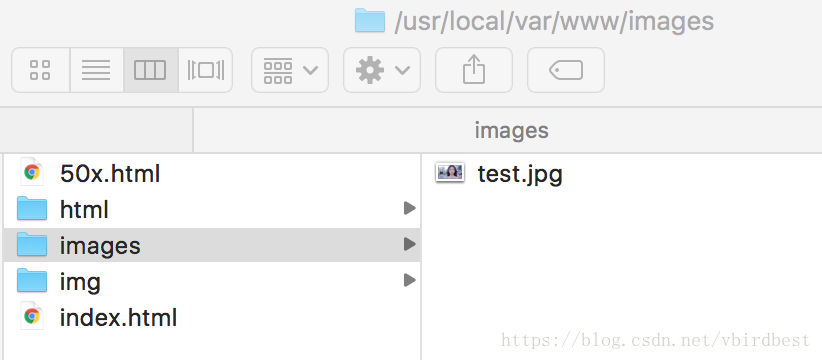彻底搞懂 Nginx 的五大应用场景
点击上方蓝色字体,选择“标星公众号”
优质文章,第一时间送达
一:HTTP服务器
user mengday staff;
http {
server {
listen 80;
server_name localhost;
client_max_body_size 1024M;
# 默认location
location / {
root /usr/local/var/www/html;
index index.html index.htm;
}
}
}
. : 匹配除换行符以外的任意字符
? : 重复0次或1次
+ : 重复1次或更多次
* : 重复0次或更多次
\d :匹配数字
^ : 匹配字符串的开始
$ : 匹配字符串的结束
{n} : 重复n次
{n,} : 重复n次或更多次
[c] : 匹配单个字符c
[a-z] : 匹配a-z小写字母的任意一个
(a|b|c) : 属线表示匹配任意一种情况,每种情况使用竖线分隔,一般使用小括号括括住,匹配符合a字符 或是b字符 或是c字符的字符串
\ 反斜杠:用于转义特殊字符
小括号()之间匹配的内容,可以在后面通过$1来引用,$2表示的是前面第二个()里的内容。正则里面容易让人困惑的是\转义特殊字符。
二:静态服务器
http {
server {
listen 80;
server_name localhost;
set $doc_root /usr/local/var/www;
# 默认location
location / {
root /usr/local/var/www/html;
index index.html index.htm;
}
location ^~ /images/ {
root $doc_root;
}
location ~* \.(gif|jpg|jpeg|png|bmp|ico|swf|css|js)$ {
root $doc_root/img;
}
}
}
= 进行普通字符精确匹配。也就是完全匹配。
^~ 前缀匹配。如果匹配成功,则不再匹配其他location。
~ 表示执行一个正则匹配,区分大小写
~* 表示执行一个正则匹配,不区分大小写
/xxx/ 常规字符串路径匹配
/ 通用匹配,任何请求都会匹配到
location优先级
location = / {
# 精确匹配/,主机名后面不能带任何字符串 /
[ configuration A ]
}
location / {
# 匹配所有以 / 开头的请求。
# 但是如果有更长的同类型的表达式,则选择更长的表达式。
# 如果有正则表达式可以匹配,则优先匹配正则表达式。
[ configuration B ]
}
location /documents/ {
# 匹配所有以 /documents/ 开头的请求,匹配符合以后,还要继续往下搜索。
# 但是如果有更长的同类型的表达式,则选择更长的表达式。
# 如果有正则表达式可以匹配,则优先匹配正则表达式。
[ configuration C ]
}
location ^~ /images/ {
# 匹配所有以 /images/ 开头的表达式,如果匹配成功,则停止匹配查找,停止搜索。
# 所以,即便有符合的正则表达式location,也不会被使用
[ configuration D ]
}
location ~* \.(gif|jpg|jpeg)$ {
# 匹配所有以 gif jpg jpeg结尾的请求。
# 但是 以 /images/开头的请求,将使用 Configuration D,D具有更高的优先级
[ configuration E ]
}
location /images/ {
# 字符匹配到 /images/,还会继续往下搜索
[ configuration F ]
}
location = /test.htm {
root /usr/local/var/www/htm;
index index.htm;
}
注意:location的优先级与location配置的位置无关
三:反向代理
server {
listen 80;
server_name localhost;
location / {
proxy_pass http://localhost:8081;
proxy_set_header Host $host:$server_port;
# 设置用户ip地址
proxy_set_header X-Forwarded-For $remote_addr;
# 当请求服务器出错去寻找其他服务器
proxy_next_upstream error timeout invalid_header http_500 http_502 http_503;
}
}
四:负载均衡
1. RR(round robin :轮询 默认):
upstream web_servers {
server localhost:8081;
server localhost:8082;
}
server {
listen 80;
server_name localhost;
#access_log logs/host.access.log main;
location / {
proxy_pass http://web_servers;
# 必须指定Header Host
proxy_set_header Host $host:$server_port;
}
}
2. 权重
upstream test {
server localhost:8081 weight=1;
server localhost:8082 weight=3;
server localhost:8083 weight=4 backup;
}
3. ip_hash
upstream test {
ip_hash;
server localhost:8080;
server localhost:8081;
}
4. fair(第三方)
upstream backend {
fair;
server localhost:8080;
server localhost:8081;
}
5. url_hash(第三方)
upstream backend {
hash $request_uri;
hash_method crc32;
server localhost:8080;
server localhost:8081;
}
五:动静分离
upstream web_servers {
server localhost:8081;
server localhost:8082;
}
server {
listen 80;
server_name localhost;
set $doc_root /usr/local/var/www;
location ~* \.(gif|jpg|jpeg|png|bmp|ico|swf|css|js)$ {
root $doc_root/img;
}
location / {
proxy_pass http://web_servers;
# 必须指定Header Host
proxy_set_header Host $host:$server_port;
}
error_page 500 502 503 504 /50x.html;
location = /50x.html {
root $doc_root;
}
}
六:其他
1.return指令
location /permanently/moved/url {
return 301 http://www.example.com/moved/here;
}
2. rewrite指令
location /users/ {
rewrite ^/users/(.*)$ /show?user=$1 break;
}
3. error_page指令
error_page 404 /404.html;
4. 日志
log_format main '$remote_addr - $remote_user [$time_local] "$request" '
'$status $body_bytes_sent "$http_referer" '
'"$http_user_agent" "$http_x_forwarded_for"';
access_log /usr/local/etc/nginx/logs/host.access.log main;
gzip on;
5. deny 指令
# 禁止访问某个目录
location ~* \.(txt|doc)${
root $doc_root;
deny all;
}
6. 内置变量
- $args : #这个变量等于请求行中的参数,同$query_string
- $content_length : 请求头中的Content-length字段。
- $content_type : 请求头中的Content-Type字段。
- $document_root : 当前请求在root指令中指定的值。
- $host : 请求主机头字段,否则为服务器名称。
- $http_user_agent : 客户端agent信息
- $http_cookie : 客户端cookie信息
- $limit_rate : 这个变量可以限制连接速率。
- $request_method : 客户端请求的动作,通常为GET或POST。
- $remote_addr : 客户端的IP地址。
- $remote_port : 客户端的端口。
- $remote_user : 已经经过Auth Basic Module验证的用户名。
- $request_filename : 当前请求的文件路径,由root或alias指令与URI请求生成。
- $scheme :HTTP方法(如http,https)。
- $server_protocol : 请求使用的协议,通常是HTTP/1.0或HTTP/1.1。
- $server_addr : 服务器地址,在完成一次系统调用后可以确定这个值。
- $server_name : 服务器名称。
- $server_port : 请求到达服务器的端口号。
- $request_uri : 包含请求参数的原始URI,不包含主机名,如:”/foo/bar.php?arg=baz”。
- $uri : 不带请求参数的当前URI,$uri不包含主机名,如”/foo/bar.html”。
- $document_uri : 与$uri相同
作者 | vbirdbest
来源 | https://blog.csdn.net/vbirdbest/article/details/80913319

评论


